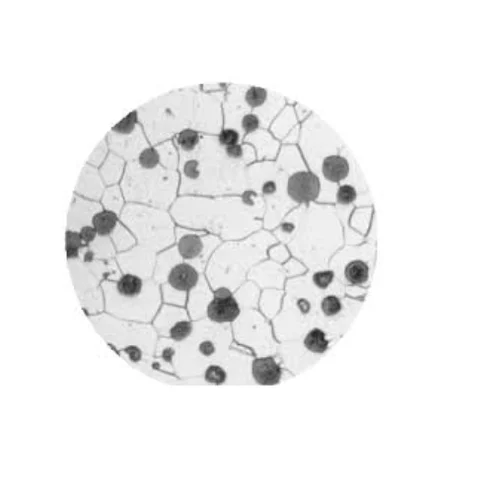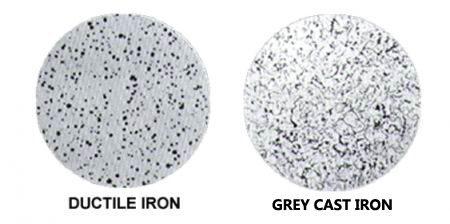Evaluation of the Quality of Ductile Iron: Graphite Morphology Transformation and Key Indicators
2025-01-17 14:58:01 hits:0
In the production of ductile iron (also known as nodular cast iron), the transformation of graphite morphology is one of the key factors influencing its mechanical properties. To ensure the quality of the castings, it is crucial that the graphite in the iron undergoes a transformation into a spherical shape, typically achieved through the "nodulizing treatment." The shape of the graphite directly impacts the cast iron's strength, toughness, wear resistance, and fatigue resistance.
1. Transformation of Graphite Morphology
In cast iron melts, graphite usually appears in flake or nodular forms. During the nodulizing treatment, a nodulizing agent (typically magnesium or aluminum alloy) is added to promote the transformation of the graphite from flake or spheroidal forms into spherical shapes. The spherical graphite significantly enhances the mechanical properties of the cast iron, particularly tensile strength and impact toughness.
2. Key Indicators for Evaluating Ductile Iron Quality
To determine the quality of ductile iron, several key indicators are commonly used:
(1) Graphite Nodularity
- Definition: Graphite nodularity refers to the degree to which the graphite particles are spherical. The higher the nodularity, the better the nodulizing effect, which results in superior mechanical properties.
- Evaluation Method: Graphite nodularity can be assessed using microscopic observation for both qualitative and quantitative analysis. Common standards include ASTM A247 and ISO 945, which assess the shape and size of the graphite particles under a microscope.
(2) Graphite Content
- Definition: Graphite content refers to the weight percentage of graphite in the cast iron. Higher graphite content helps improve toughness and fatigue resistance.
- Evaluation Method: Graphite content can be determined through chemical analysis (such as spectrometry) or microscopic examination. In ductile iron, graphite content typically ranges from 2% to 4%.
(3) Tensile Strength
- Definition: Tensile strength measures a material's ability to withstand maximum stress before breaking under tension. Ductile iron typically exhibits high tensile strength, allowing it to bear substantial external loads.
- Evaluation Method: Tensile testing (according to ASTM A48 or ISO 1083) provides tensile strength data for ductile iron. Typical tensile strength ranges from 200 to 1000 MPa, depending on the grade and alloy composition.
(4) Hardness
- Definition: Hardness measures a material's resistance to indentation or abrasion. The hardness of ductile iron is related to its graphite nodularity, alloy composition, and heat treatment.
- Evaluation Method: Hardness is usually tested using Brinell hardness (HB), Rockwell hardness (HRB), or Vickers hardness (HV) methods. The hardness level directly impacts the wear resistance of the cast iron.
(5) Impact Toughness
- Definition: Impact toughness indicates a material's ability to absorb energy under sudden impact loads. Ductile iron exhibits excellent impact toughness, making it ideal for applications requiring high toughness and fatigue resistance, such as in automotive parts.
- Evaluation Method: Impact tests, such as the Charpy impact test, are used to evaluate the impact toughness of ductile iron. High impact toughness ensures that the casting can withstand significant external shock without breaking.
(6) Microstructure
- Definition: The microstructure of ductile iron includes the distribution, size, and shape of the graphite particles, as well as the matrix structure (such as ferrite, pearlite, or martensite). The uniformity of the microstructure and the distribution of graphite particles significantly affect the mechanical properties of the casting.
- Evaluation Method: Microscopic observation and metallographic analysis provide insight into the microstructure of ductile iron. High-quality ductile iron typically exhibits a uniform distribution of spherical graphite particles and a desirable matrix structure.
(7) Fracture Toughness
- Definition: Fracture toughness is the ability of a material to resist crack propagation. Ductile iron is known for its high fracture toughness, which is critical for applications where the material may experience sudden or extreme loads.
- Evaluation Method: Fracture toughness is evaluated through tests such as the CT (Compact Tension) test. High fracture toughness ensures the reliability and durability of the castings under extreme conditions.
(8) Casting Defects
- Definition: Casting defects such as porosity, cracks, and inclusions can significantly degrade the mechanical properties of ductile iron, particularly its strength and toughness.
- Evaluation Method: Non-destructive testing (NDT) methods, such as X-ray, ultrasound, magnetic particle testing, or dye penetrant testing, are used to detect defects within castings, ensuring their overall quality.
3. Conclusion
The quality of ductile iron depends not only on the transformation of graphite into a spherical shape but also on several other factors, including graphite content, alloy composition, casting process, and heat treatment. To ensure high-quality ductile iron, it is essential to evaluate these indicators comprehensively. Common evaluation methods include microscopic examination, hardness testing, tensile testing, impact toughness testing, and non-destructive testing. Through precise control and evaluation, high-performance ductile iron can be produced to meet the demanding requirements of automotive, machinery, and other high-performance applications.

 en
en  fra
fra  de
de  ru
ru  gle
gle  th
th  ara
ara  it
it  jp
jp  kor
kor  zh
zh 





